LSBM100 - Managing Information and Technology: Tesco Report & Analysis
VerifiedAdded on 2023/01/12
|11
|3702
|28
Report
AI Summary
This report provides a comprehensive analysis of Tesco's information system, examining its application within the retail industry. The introduction highlights the importance of managing IT systems for competitive advantage, using Tesco as a case study. The report delves into Tesco's background, competitive environment through Porter's Five Forces analysis, and the bargaining power of buyers and suppliers. It also assesses the threats of substitutes and new entrants, as well as the rivalry among existing players. Furthermore, it examines Tesco's inbound and outbound logistics, and operations. The report analyzes activities within Porter's value chain, identifies key value-adding activities, and discusses the deployment of information systems for improved productivity. The analysis covers various aspects of Tesco's business operations and how information technology supports its strategic goals, concluding with insights into the company's overall performance and future prospects.
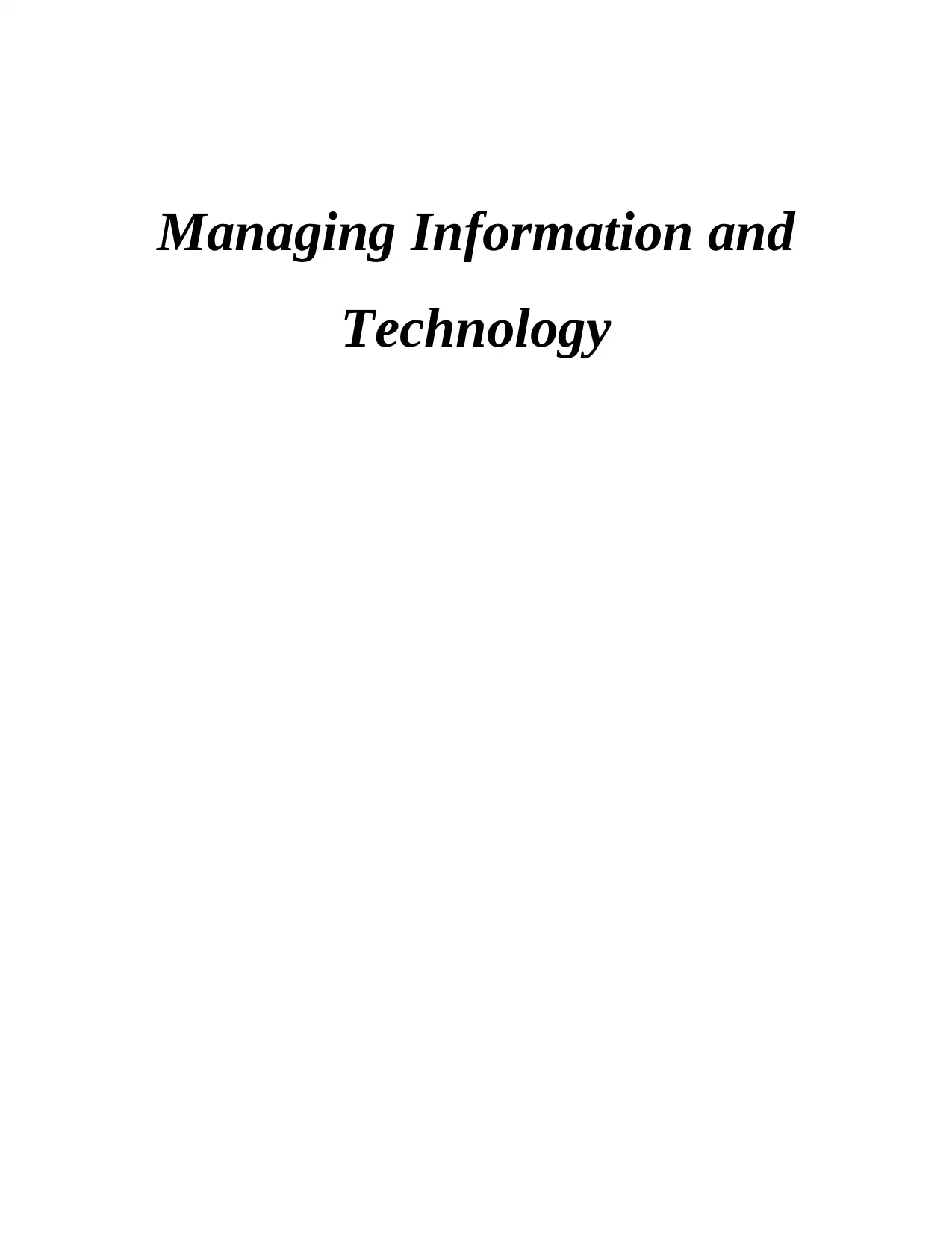
Managing Information and
Technology
Technology
Paraphrase This Document
Need a fresh take? Get an instant paraphrase of this document with our AI Paraphraser
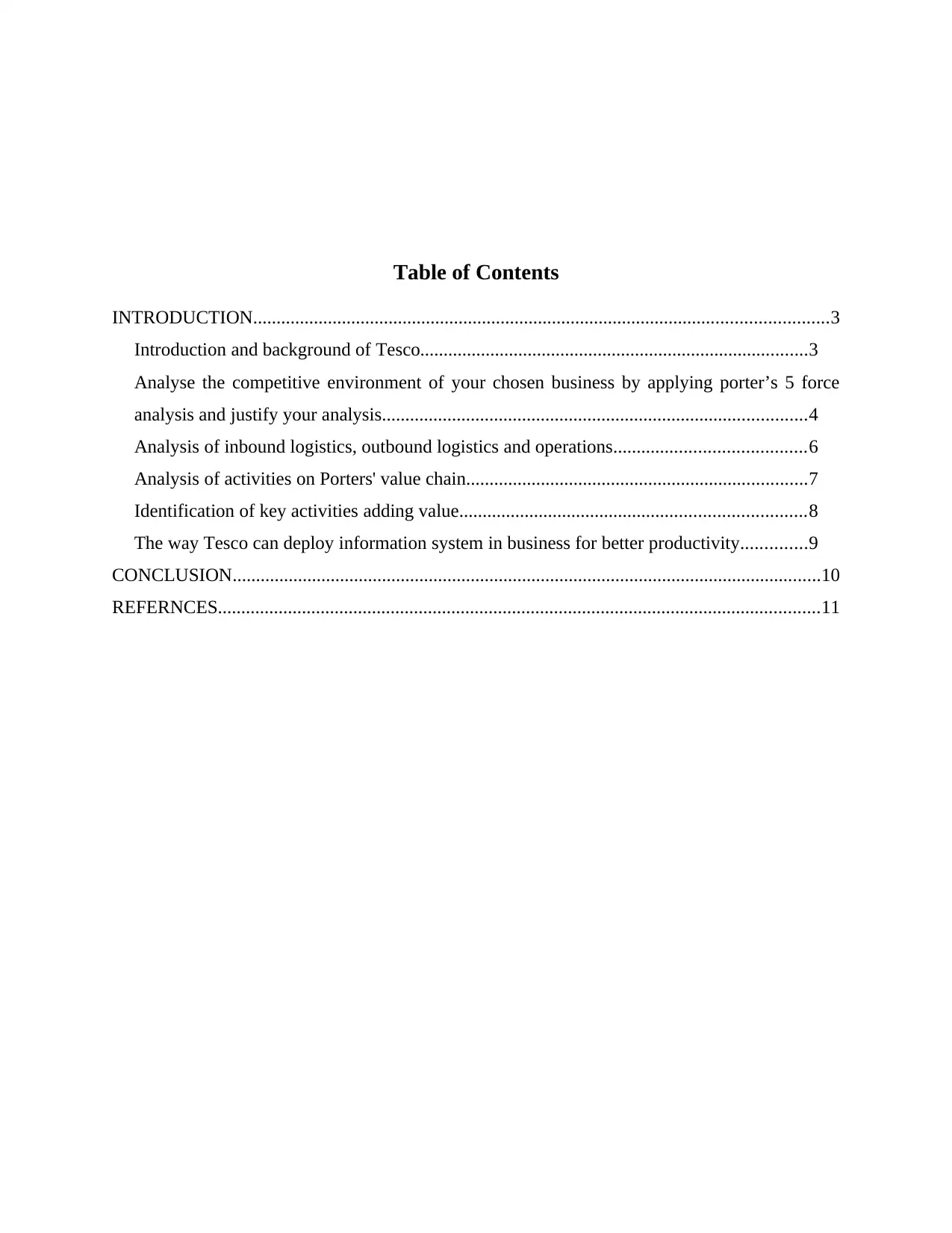
Table of Contents
INTRODUCTION...........................................................................................................................3
Introduction and background of Tesco...................................................................................3
Analyse the competitive environment of your chosen business by applying porter’s 5 force
analysis and justify your analysis...........................................................................................4
Analysis of inbound logistics, outbound logistics and operations.........................................6
Analysis of activities on Porters' value chain.........................................................................7
Identification of key activities adding value..........................................................................8
The way Tesco can deploy information system in business for better productivity..............9
CONCLUSION..............................................................................................................................10
REFERNCES.................................................................................................................................11
INTRODUCTION...........................................................................................................................3
Introduction and background of Tesco...................................................................................3
Analyse the competitive environment of your chosen business by applying porter’s 5 force
analysis and justify your analysis...........................................................................................4
Analysis of inbound logistics, outbound logistics and operations.........................................6
Analysis of activities on Porters' value chain.........................................................................7
Identification of key activities adding value..........................................................................8
The way Tesco can deploy information system in business for better productivity..............9
CONCLUSION..............................................................................................................................10
REFERNCES.................................................................................................................................11
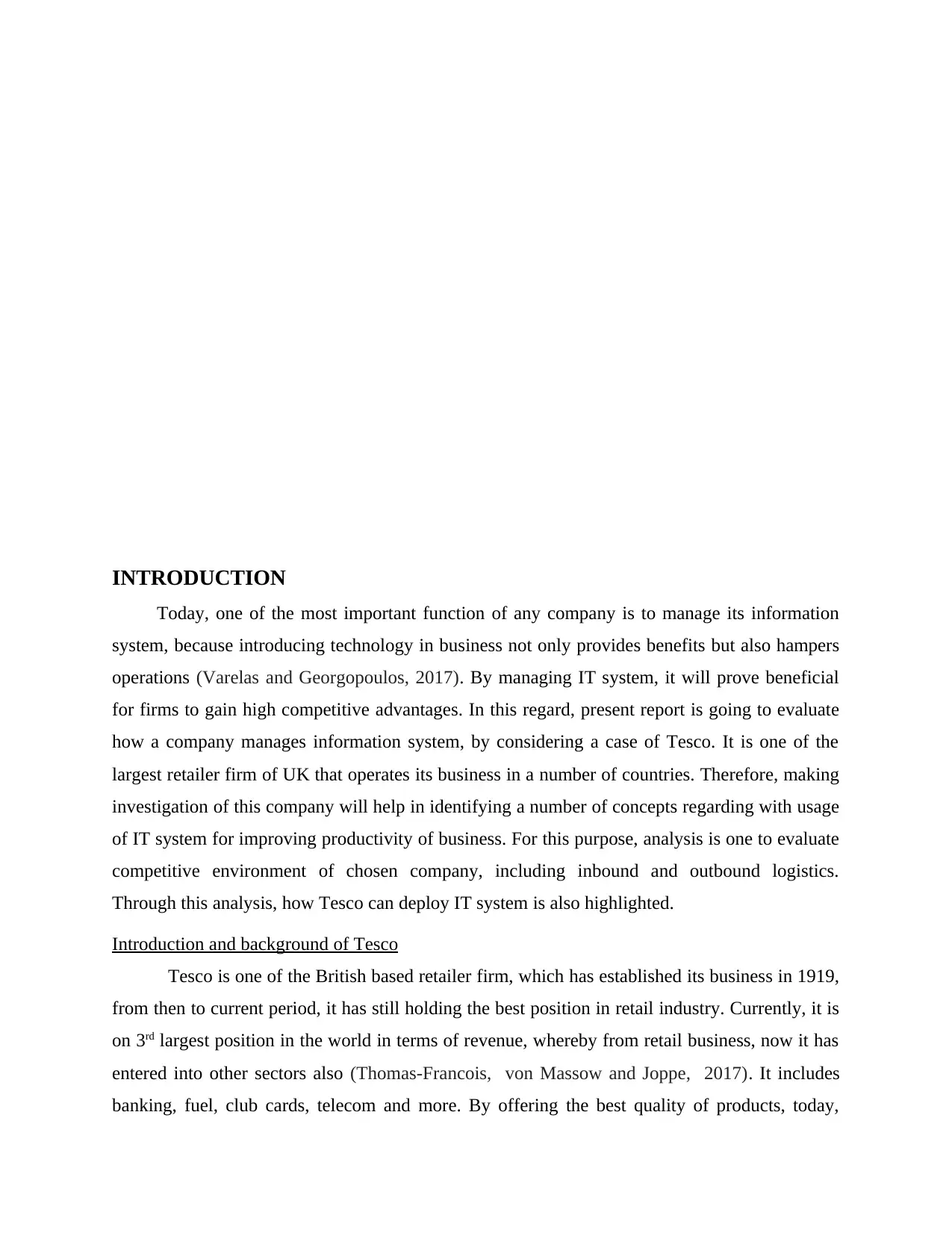
INTRODUCTION
Today, one of the most important function of any company is to manage its information
system, because introducing technology in business not only provides benefits but also hampers
operations (Varelas and Georgopoulos, 2017). By managing IT system, it will prove beneficial
for firms to gain high competitive advantages. In this regard, present report is going to evaluate
how a company manages information system, by considering a case of Tesco. It is one of the
largest retailer firm of UK that operates its business in a number of countries. Therefore, making
investigation of this company will help in identifying a number of concepts regarding with usage
of IT system for improving productivity of business. For this purpose, analysis is one to evaluate
competitive environment of chosen company, including inbound and outbound logistics.
Through this analysis, how Tesco can deploy IT system is also highlighted.
Introduction and background of Tesco
Tesco is one of the British based retailer firm, which has established its business in 1919,
from then to current period, it has still holding the best position in retail industry. Currently, it is
on 3rd largest position in the world in terms of revenue, whereby from retail business, now it has
entered into other sectors also (Thomas-Francois, von Massow and Joppe, 2017). It includes
banking, fuel, club cards, telecom and more. By offering the best quality of products, today,
Today, one of the most important function of any company is to manage its information
system, because introducing technology in business not only provides benefits but also hampers
operations (Varelas and Georgopoulos, 2017). By managing IT system, it will prove beneficial
for firms to gain high competitive advantages. In this regard, present report is going to evaluate
how a company manages information system, by considering a case of Tesco. It is one of the
largest retailer firm of UK that operates its business in a number of countries. Therefore, making
investigation of this company will help in identifying a number of concepts regarding with usage
of IT system for improving productivity of business. For this purpose, analysis is one to evaluate
competitive environment of chosen company, including inbound and outbound logistics.
Through this analysis, how Tesco can deploy IT system is also highlighted.
Introduction and background of Tesco
Tesco is one of the British based retailer firm, which has established its business in 1919,
from then to current period, it has still holding the best position in retail industry. Currently, it is
on 3rd largest position in the world in terms of revenue, whereby from retail business, now it has
entered into other sectors also (Thomas-Francois, von Massow and Joppe, 2017). It includes
banking, fuel, club cards, telecom and more. By offering the best quality of products, today,
⊘ This is a preview!⊘
Do you want full access?
Subscribe today to unlock all pages.

Trusted by 1+ million students worldwide
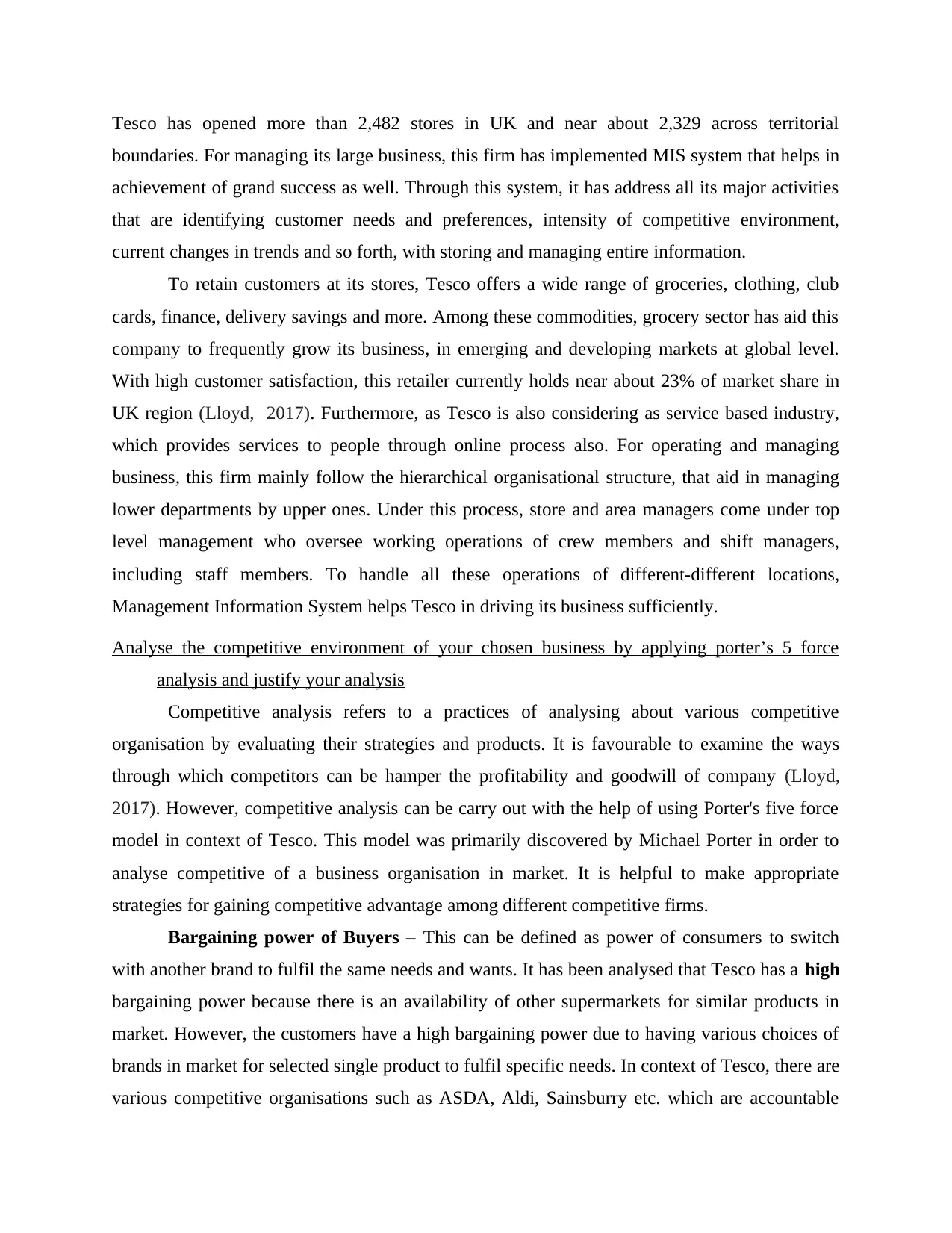
Tesco has opened more than 2,482 stores in UK and near about 2,329 across territorial
boundaries. For managing its large business, this firm has implemented MIS system that helps in
achievement of grand success as well. Through this system, it has address all its major activities
that are identifying customer needs and preferences, intensity of competitive environment,
current changes in trends and so forth, with storing and managing entire information.
To retain customers at its stores, Tesco offers a wide range of groceries, clothing, club
cards, finance, delivery savings and more. Among these commodities, grocery sector has aid this
company to frequently grow its business, in emerging and developing markets at global level.
With high customer satisfaction, this retailer currently holds near about 23% of market share in
UK region (Lloyd, 2017). Furthermore, as Tesco is also considering as service based industry,
which provides services to people through online process also. For operating and managing
business, this firm mainly follow the hierarchical organisational structure, that aid in managing
lower departments by upper ones. Under this process, store and area managers come under top
level management who oversee working operations of crew members and shift managers,
including staff members. To handle all these operations of different-different locations,
Management Information System helps Tesco in driving its business sufficiently.
Analyse the competitive environment of your chosen business by applying porter’s 5 force
analysis and justify your analysis
Competitive analysis refers to a practices of analysing about various competitive
organisation by evaluating their strategies and products. It is favourable to examine the ways
through which competitors can be hamper the profitability and goodwill of company (Lloyd,
2017). However, competitive analysis can be carry out with the help of using Porter's five force
model in context of Tesco. This model was primarily discovered by Michael Porter in order to
analyse competitive of a business organisation in market. It is helpful to make appropriate
strategies for gaining competitive advantage among different competitive firms.
Bargaining power of Buyers – This can be defined as power of consumers to switch
with another brand to fulfil the same needs and wants. It has been analysed that Tesco has a high
bargaining power because there is an availability of other supermarkets for similar products in
market. However, the customers have a high bargaining power due to having various choices of
brands in market for selected single product to fulfil specific needs. In context of Tesco, there are
various competitive organisations such as ASDA, Aldi, Sainsburry etc. which are accountable
boundaries. For managing its large business, this firm has implemented MIS system that helps in
achievement of grand success as well. Through this system, it has address all its major activities
that are identifying customer needs and preferences, intensity of competitive environment,
current changes in trends and so forth, with storing and managing entire information.
To retain customers at its stores, Tesco offers a wide range of groceries, clothing, club
cards, finance, delivery savings and more. Among these commodities, grocery sector has aid this
company to frequently grow its business, in emerging and developing markets at global level.
With high customer satisfaction, this retailer currently holds near about 23% of market share in
UK region (Lloyd, 2017). Furthermore, as Tesco is also considering as service based industry,
which provides services to people through online process also. For operating and managing
business, this firm mainly follow the hierarchical organisational structure, that aid in managing
lower departments by upper ones. Under this process, store and area managers come under top
level management who oversee working operations of crew members and shift managers,
including staff members. To handle all these operations of different-different locations,
Management Information System helps Tesco in driving its business sufficiently.
Analyse the competitive environment of your chosen business by applying porter’s 5 force
analysis and justify your analysis
Competitive analysis refers to a practices of analysing about various competitive
organisation by evaluating their strategies and products. It is favourable to examine the ways
through which competitors can be hamper the profitability and goodwill of company (Lloyd,
2017). However, competitive analysis can be carry out with the help of using Porter's five force
model in context of Tesco. This model was primarily discovered by Michael Porter in order to
analyse competitive of a business organisation in market. It is helpful to make appropriate
strategies for gaining competitive advantage among different competitive firms.
Bargaining power of Buyers – This can be defined as power of consumers to switch
with another brand to fulfil the same needs and wants. It has been analysed that Tesco has a high
bargaining power because there is an availability of other supermarkets for similar products in
market. However, the customers have a high bargaining power due to having various choices of
brands in market for selected single product to fulfil specific needs. In context of Tesco, there are
various competitive organisations such as ASDA, Aldi, Sainsburry etc. which are accountable
Paraphrase This Document
Need a fresh take? Get an instant paraphrase of this document with our AI Paraphraser

for offering similar goods & services at relevant costs. In addition to this, customers have limited
budget but they demand new features and easily get switch to other brand fort better services due
to which bargaining power of consumers become high for given company. Basically, existence
of several competitors in market is responsible for making switching price low which enhance
customer power to select among variety of products in same range of price (Senft, Gallegos and
Davis, 2016). It is observed that people desires high quality of products affiliated with low prices
and they have a behaviour of opting to purchase goods from discounting stores such as Aldi and
Lidl which is liable for reducing market share of Tesco. Moreover, the given organisation has
slashed in prices in regards to around 2000 vegetables and fruits for promoting healthy eating as
well as enhancing respective sales.
Bargaining power of suppliers – The suppliers plays an important role in terms of
proceeding smooth manufacturing and supplying finished goods in market. It includes that there
is a low bargaining power of suppliers associated with Tesco because of existing number of
suppliers in the supermarket retail industry. However, it is favourable for given organisation to
easily switch to suitable suppliers for purchasing raw material in bulk with reasonable cost that
facilitate to boost up respective profit margin. They can buy goods at lowest price in order to
enhance profits margin that has led to lose on the side of suppliers. Meanwhile, it has been
analysed that every company put efforts to specifically establish strategies for increasing
profitability which is automatically happen in case of Tesco due to having low bargaining power
of suppliers in market. The given organisation has another benefit then if they feel reduction in
quality then they can easily switch to other suppliers for maintaining their quality of product
provided to customers.
Threat of substitutes – This can be defined as availability of substitutes products and
services which is accountable for influencing sales of the organisation. In context of Tesco, the
threat of substitutes is observed to be very high in grocery market among both grocery as well as
non grocery items. This situation exists for given company because of potential good substitutes
comes from retailers in other markets that is liable for providing both food product as well as
drinks directly to consumers along with non-food products including electronics, furniture,
clothing etc (Simatupang, Piboonrungroj and Williams, 2017). However, it involves for
example department stores and non-food retailers with both scale as well as distribution for
completing with Tesco. The companies accountable for increasing offer of substitutes product
budget but they demand new features and easily get switch to other brand fort better services due
to which bargaining power of consumers become high for given company. Basically, existence
of several competitors in market is responsible for making switching price low which enhance
customer power to select among variety of products in same range of price (Senft, Gallegos and
Davis, 2016). It is observed that people desires high quality of products affiliated with low prices
and they have a behaviour of opting to purchase goods from discounting stores such as Aldi and
Lidl which is liable for reducing market share of Tesco. Moreover, the given organisation has
slashed in prices in regards to around 2000 vegetables and fruits for promoting healthy eating as
well as enhancing respective sales.
Bargaining power of suppliers – The suppliers plays an important role in terms of
proceeding smooth manufacturing and supplying finished goods in market. It includes that there
is a low bargaining power of suppliers associated with Tesco because of existing number of
suppliers in the supermarket retail industry. However, it is favourable for given organisation to
easily switch to suitable suppliers for purchasing raw material in bulk with reasonable cost that
facilitate to boost up respective profit margin. They can buy goods at lowest price in order to
enhance profits margin that has led to lose on the side of suppliers. Meanwhile, it has been
analysed that every company put efforts to specifically establish strategies for increasing
profitability which is automatically happen in case of Tesco due to having low bargaining power
of suppliers in market. The given organisation has another benefit then if they feel reduction in
quality then they can easily switch to other suppliers for maintaining their quality of product
provided to customers.
Threat of substitutes – This can be defined as availability of substitutes products and
services which is accountable for influencing sales of the organisation. In context of Tesco, the
threat of substitutes is observed to be very high in grocery market among both grocery as well as
non grocery items. This situation exists for given company because of potential good substitutes
comes from retailers in other markets that is liable for providing both food product as well as
drinks directly to consumers along with non-food products including electronics, furniture,
clothing etc (Simatupang, Piboonrungroj and Williams, 2017). However, it involves for
example department stores and non-food retailers with both scale as well as distribution for
completing with Tesco. The companies accountable for increasing offer of substitutes product
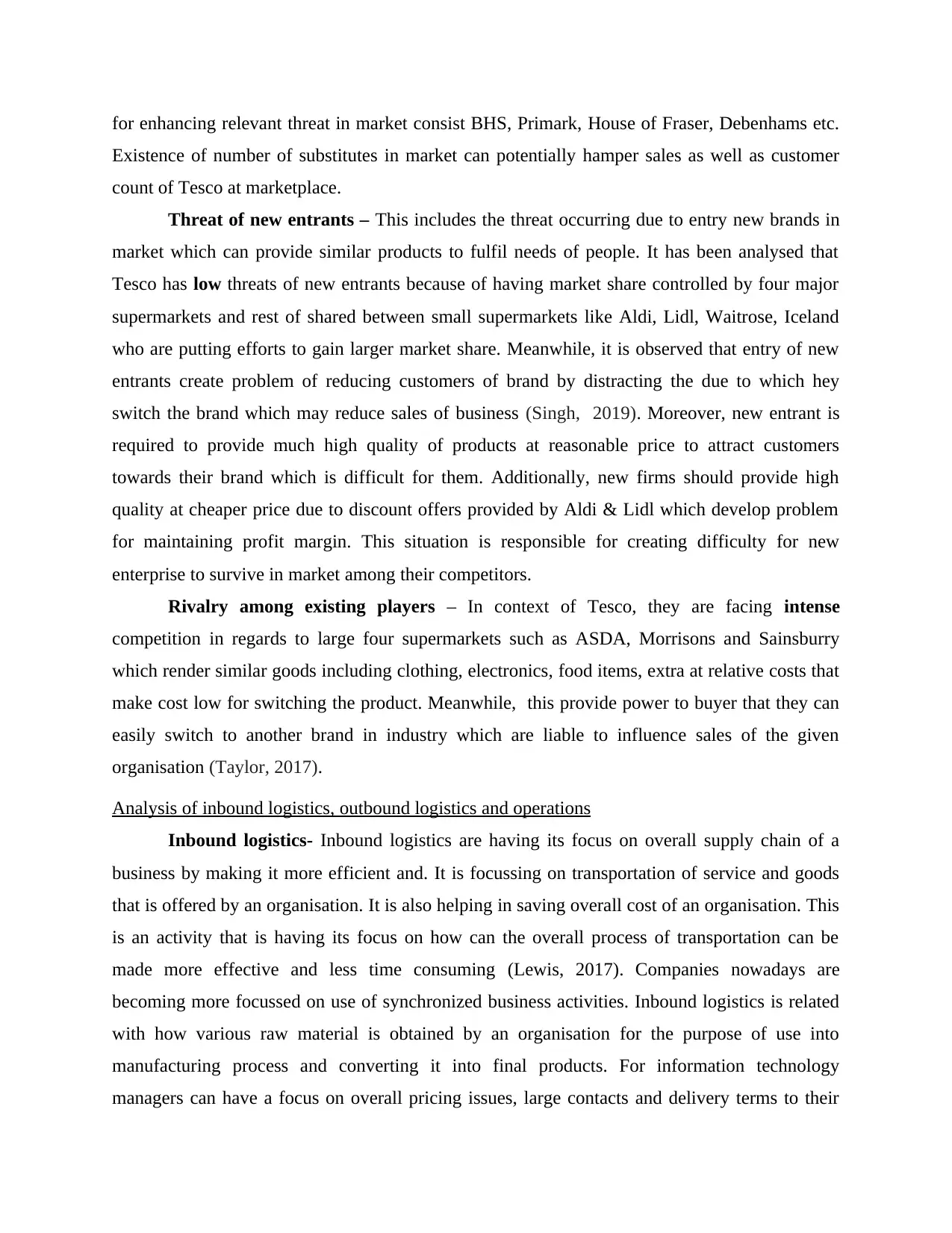
for enhancing relevant threat in market consist BHS, Primark, House of Fraser, Debenhams etc.
Existence of number of substitutes in market can potentially hamper sales as well as customer
count of Tesco at marketplace.
Threat of new entrants – This includes the threat occurring due to entry new brands in
market which can provide similar products to fulfil needs of people. It has been analysed that
Tesco has low threats of new entrants because of having market share controlled by four major
supermarkets and rest of shared between small supermarkets like Aldi, Lidl, Waitrose, Iceland
who are putting efforts to gain larger market share. Meanwhile, it is observed that entry of new
entrants create problem of reducing customers of brand by distracting the due to which hey
switch the brand which may reduce sales of business (Singh, 2019). Moreover, new entrant is
required to provide much high quality of products at reasonable price to attract customers
towards their brand which is difficult for them. Additionally, new firms should provide high
quality at cheaper price due to discount offers provided by Aldi & Lidl which develop problem
for maintaining profit margin. This situation is responsible for creating difficulty for new
enterprise to survive in market among their competitors.
Rivalry among existing players – In context of Tesco, they are facing intense
competition in regards to large four supermarkets such as ASDA, Morrisons and Sainsburry
which render similar goods including clothing, electronics, food items, extra at relative costs that
make cost low for switching the product. Meanwhile, this provide power to buyer that they can
easily switch to another brand in industry which are liable to influence sales of the given
organisation (Taylor, 2017).
Analysis of inbound logistics, outbound logistics and operations
Inbound logistics- Inbound logistics are having its focus on overall supply chain of a
business by making it more efficient and. It is focussing on transportation of service and goods
that is offered by an organisation. It is also helping in saving overall cost of an organisation. This
is an activity that is having its focus on how can the overall process of transportation can be
made more effective and less time consuming (Lewis, 2017). Companies nowadays are
becoming more focussed on use of synchronized business activities. Inbound logistics is related
with how various raw material is obtained by an organisation for the purpose of use into
manufacturing process and converting it into final products. For information technology
managers can have a focus on overall pricing issues, large contacts and delivery terms to their
Existence of number of substitutes in market can potentially hamper sales as well as customer
count of Tesco at marketplace.
Threat of new entrants – This includes the threat occurring due to entry new brands in
market which can provide similar products to fulfil needs of people. It has been analysed that
Tesco has low threats of new entrants because of having market share controlled by four major
supermarkets and rest of shared between small supermarkets like Aldi, Lidl, Waitrose, Iceland
who are putting efforts to gain larger market share. Meanwhile, it is observed that entry of new
entrants create problem of reducing customers of brand by distracting the due to which hey
switch the brand which may reduce sales of business (Singh, 2019). Moreover, new entrant is
required to provide much high quality of products at reasonable price to attract customers
towards their brand which is difficult for them. Additionally, new firms should provide high
quality at cheaper price due to discount offers provided by Aldi & Lidl which develop problem
for maintaining profit margin. This situation is responsible for creating difficulty for new
enterprise to survive in market among their competitors.
Rivalry among existing players – In context of Tesco, they are facing intense
competition in regards to large four supermarkets such as ASDA, Morrisons and Sainsburry
which render similar goods including clothing, electronics, food items, extra at relative costs that
make cost low for switching the product. Meanwhile, this provide power to buyer that they can
easily switch to another brand in industry which are liable to influence sales of the given
organisation (Taylor, 2017).
Analysis of inbound logistics, outbound logistics and operations
Inbound logistics- Inbound logistics are having its focus on overall supply chain of a
business by making it more efficient and. It is focussing on transportation of service and goods
that is offered by an organisation. It is also helping in saving overall cost of an organisation. This
is an activity that is having its focus on how can the overall process of transportation can be
made more effective and less time consuming (Lewis, 2017). Companies nowadays are
becoming more focussed on use of synchronized business activities. Inbound logistics is related
with how various raw material is obtained by an organisation for the purpose of use into
manufacturing process and converting it into final products. For information technology
managers can have a focus on overall pricing issues, large contacts and delivery terms to their
⊘ This is a preview!⊘
Do you want full access?
Subscribe today to unlock all pages.

Trusted by 1+ million students worldwide

customers. All these are very important issues that have to be focussed by managers in every
organisation. In context of Tesco, this company is focussing on management technology system
so that they are able to use it for effective use of their resources (Lee and Tang, 2018). Since
1970 this organisation is working towards achievement of their overall objectives. Another
aspect is information sharing that is concerns with making process more transparent for keeping
material in order. This is tool that is related with management of cost.
Operations- Operations is a process that is related with conversion of raw materials in
finished goods. Company is using this process in order to save the time invested and cost
associated with it. TESCO is using this process for managing their inventory, displaying of their
products and management of stock in order to get a competitive advantage as compared to their
competitors.
Outbound Logistics- Outbound Logistics is a procedure that is connects with how
organisation is storing their products, transporting it and distributing to their customers. The
overall process starts with the order placed by customers, packing in warehouses and ends with
the product being delivered to their customers. Tesco is offering home delivery facility to their
customers to increase convenience to their customers (Hernandez. and Pedersen, 2017). It is also
said that company is making efforts for making space for trolley, parking facility, having skilled
and competent staff. All these efforts are done in order to supply to their customers increased
convenience facility.
Analysis of activities on Porters' value chain
Porter's value chain- This is a value chain, that is divided on two parts that is primary
activities and secondary activities. Primary h- this includes activities that are related with
transportation of finished goods, managing of inventory stocks and warehousing facility. as five
main activities as discussed below:
Inbound logistics- this includes activities that are related with transportation of finished
goods, managing of inventory stocks and warehousing facility.
Operations- This function consists of process related to converting raw material in
finished goods so that it can be delivered to their customers.
Outbound logistics- This is a function that is helping in delivering of products to their
customers.
organisation. In context of Tesco, this company is focussing on management technology system
so that they are able to use it for effective use of their resources (Lee and Tang, 2018). Since
1970 this organisation is working towards achievement of their overall objectives. Another
aspect is information sharing that is concerns with making process more transparent for keeping
material in order. This is tool that is related with management of cost.
Operations- Operations is a process that is related with conversion of raw materials in
finished goods. Company is using this process in order to save the time invested and cost
associated with it. TESCO is using this process for managing their inventory, displaying of their
products and management of stock in order to get a competitive advantage as compared to their
competitors.
Outbound Logistics- Outbound Logistics is a procedure that is connects with how
organisation is storing their products, transporting it and distributing to their customers. The
overall process starts with the order placed by customers, packing in warehouses and ends with
the product being delivered to their customers. Tesco is offering home delivery facility to their
customers to increase convenience to their customers (Hernandez. and Pedersen, 2017). It is also
said that company is making efforts for making space for trolley, parking facility, having skilled
and competent staff. All these efforts are done in order to supply to their customers increased
convenience facility.
Analysis of activities on Porters' value chain
Porter's value chain- This is a value chain, that is divided on two parts that is primary
activities and secondary activities. Primary h- this includes activities that are related with
transportation of finished goods, managing of inventory stocks and warehousing facility. as five
main activities as discussed below:
Inbound logistics- this includes activities that are related with transportation of finished
goods, managing of inventory stocks and warehousing facility.
Operations- This function consists of process related to converting raw material in
finished goods so that it can be delivered to their customers.
Outbound logistics- This is a function that is helping in delivering of products to their
customers.
Paraphrase This Document
Need a fresh take? Get an instant paraphrase of this document with our AI Paraphraser
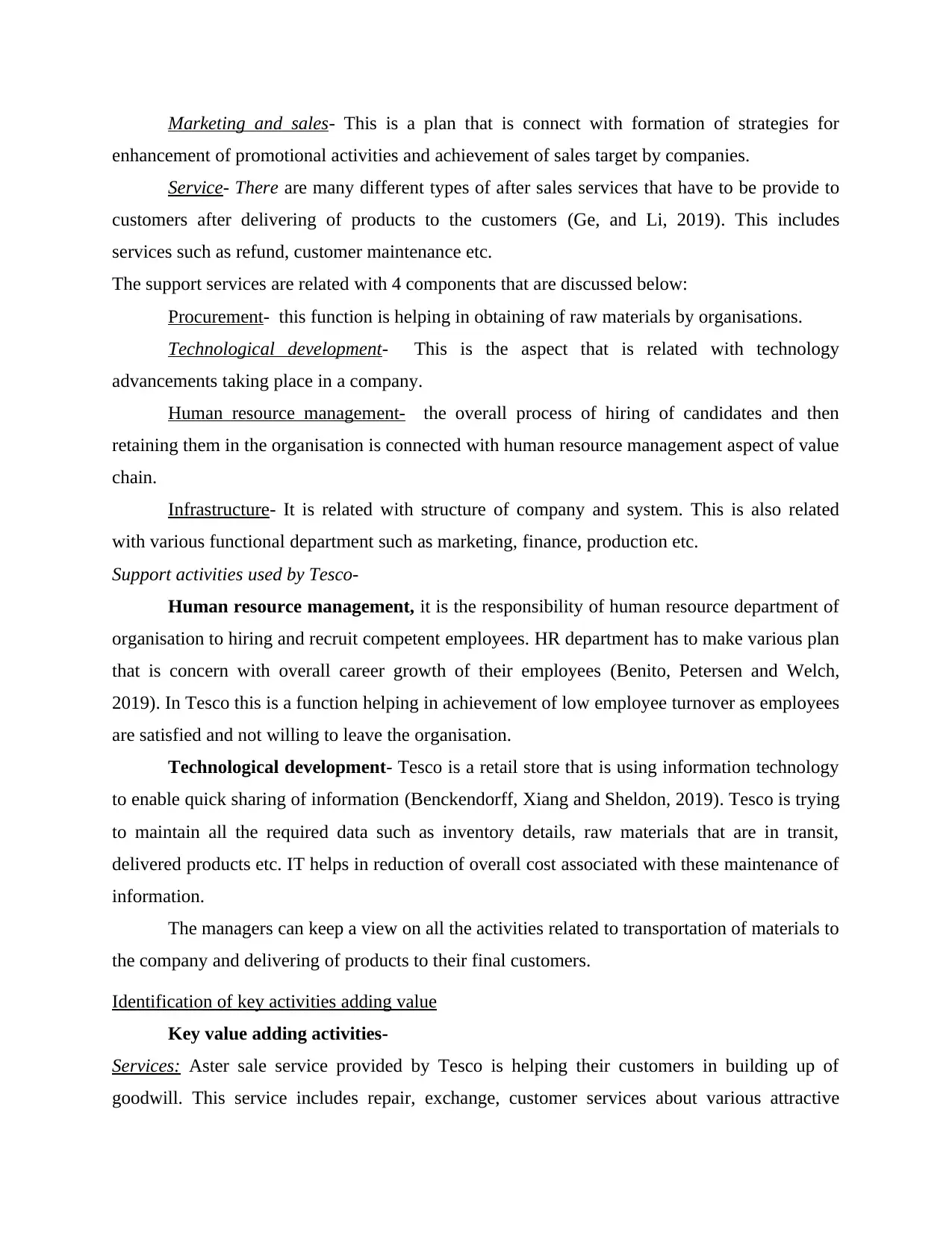
Marketing and sales- This is a plan that is connect with formation of strategies for
enhancement of promotional activities and achievement of sales target by companies.
Service- There are many different types of after sales services that have to be provide to
customers after delivering of products to the customers (Ge, and Li, 2019). This includes
services such as refund, customer maintenance etc.
The support services are related with 4 components that are discussed below:
Procurement- this function is helping in obtaining of raw materials by organisations.
Technological development- This is the aspect that is related with technology
advancements taking place in a company.
Human resource management- the overall process of hiring of candidates and then
retaining them in the organisation is connected with human resource management aspect of value
chain.
Infrastructure- It is related with structure of company and system. This is also related
with various functional department such as marketing, finance, production etc.
Support activities used by Tesco-
Human resource management, it is the responsibility of human resource department of
organisation to hiring and recruit competent employees. HR department has to make various plan
that is concern with overall career growth of their employees (Benito, Petersen and Welch,
2019). In Tesco this is a function helping in achievement of low employee turnover as employees
are satisfied and not willing to leave the organisation.
Technological development- Tesco is a retail store that is using information technology
to enable quick sharing of information (Benckendorff, Xiang and Sheldon, 2019). Tesco is trying
to maintain all the required data such as inventory details, raw materials that are in transit,
delivered products etc. IT helps in reduction of overall cost associated with these maintenance of
information.
The managers can keep a view on all the activities related to transportation of materials to
the company and delivering of products to their final customers.
Identification of key activities adding value
Key value adding activities-
Services: Aster sale service provided by Tesco is helping their customers in building up of
goodwill. This service includes repair, exchange, customer services about various attractive
enhancement of promotional activities and achievement of sales target by companies.
Service- There are many different types of after sales services that have to be provide to
customers after delivering of products to the customers (Ge, and Li, 2019). This includes
services such as refund, customer maintenance etc.
The support services are related with 4 components that are discussed below:
Procurement- this function is helping in obtaining of raw materials by organisations.
Technological development- This is the aspect that is related with technology
advancements taking place in a company.
Human resource management- the overall process of hiring of candidates and then
retaining them in the organisation is connected with human resource management aspect of value
chain.
Infrastructure- It is related with structure of company and system. This is also related
with various functional department such as marketing, finance, production etc.
Support activities used by Tesco-
Human resource management, it is the responsibility of human resource department of
organisation to hiring and recruit competent employees. HR department has to make various plan
that is concern with overall career growth of their employees (Benito, Petersen and Welch,
2019). In Tesco this is a function helping in achievement of low employee turnover as employees
are satisfied and not willing to leave the organisation.
Technological development- Tesco is a retail store that is using information technology
to enable quick sharing of information (Benckendorff, Xiang and Sheldon, 2019). Tesco is trying
to maintain all the required data such as inventory details, raw materials that are in transit,
delivered products etc. IT helps in reduction of overall cost associated with these maintenance of
information.
The managers can keep a view on all the activities related to transportation of materials to
the company and delivering of products to their final customers.
Identification of key activities adding value
Key value adding activities-
Services: Aster sale service provided by Tesco is helping their customers in building up of
goodwill. This service includes repair, exchange, customer services about various attractive
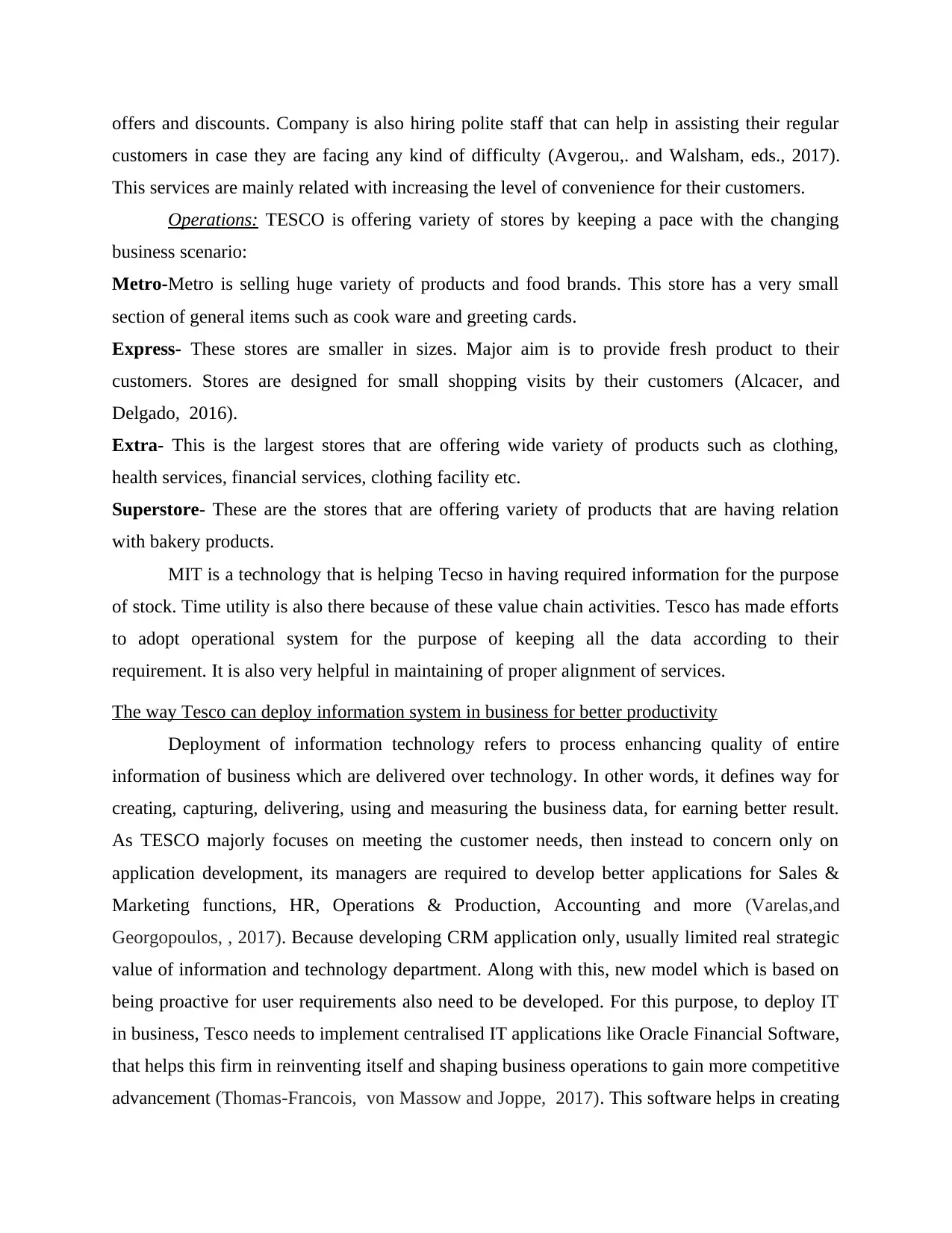
offers and discounts. Company is also hiring polite staff that can help in assisting their regular
customers in case they are facing any kind of difficulty (Avgerou,. and Walsham, eds., 2017).
This services are mainly related with increasing the level of convenience for their customers.
Operations: TESCO is offering variety of stores by keeping a pace with the changing
business scenario:
Metro-Metro is selling huge variety of products and food brands. This store has a very small
section of general items such as cook ware and greeting cards.
Express- These stores are smaller in sizes. Major aim is to provide fresh product to their
customers. Stores are designed for small shopping visits by their customers (Alcacer, and
Delgado, 2016).
Extra- This is the largest stores that are offering wide variety of products such as clothing,
health services, financial services, clothing facility etc.
Superstore- These are the stores that are offering variety of products that are having relation
with bakery products.
MIT is a technology that is helping Tecso in having required information for the purpose
of stock. Time utility is also there because of these value chain activities. Tesco has made efforts
to adopt operational system for the purpose of keeping all the data according to their
requirement. It is also very helpful in maintaining of proper alignment of services.
The way Tesco can deploy information system in business for better productivity
Deployment of information technology refers to process enhancing quality of entire
information of business which are delivered over technology. In other words, it defines way for
creating, capturing, delivering, using and measuring the business data, for earning better result.
As TESCO majorly focuses on meeting the customer needs, then instead to concern only on
application development, its managers are required to develop better applications for Sales &
Marketing functions, HR, Operations & Production, Accounting and more (Varelas,and
Georgopoulos, , 2017). Because developing CRM application only, usually limited real strategic
value of information and technology department. Along with this, new model which is based on
being proactive for user requirements also need to be developed. For this purpose, to deploy IT
in business, Tesco needs to implement centralised IT applications like Oracle Financial Software,
that helps this firm in reinventing itself and shaping business operations to gain more competitive
advancement (Thomas-Francois, von Massow and Joppe, 2017). This software helps in creating
customers in case they are facing any kind of difficulty (Avgerou,. and Walsham, eds., 2017).
This services are mainly related with increasing the level of convenience for their customers.
Operations: TESCO is offering variety of stores by keeping a pace with the changing
business scenario:
Metro-Metro is selling huge variety of products and food brands. This store has a very small
section of general items such as cook ware and greeting cards.
Express- These stores are smaller in sizes. Major aim is to provide fresh product to their
customers. Stores are designed for small shopping visits by their customers (Alcacer, and
Delgado, 2016).
Extra- This is the largest stores that are offering wide variety of products such as clothing,
health services, financial services, clothing facility etc.
Superstore- These are the stores that are offering variety of products that are having relation
with bakery products.
MIT is a technology that is helping Tecso in having required information for the purpose
of stock. Time utility is also there because of these value chain activities. Tesco has made efforts
to adopt operational system for the purpose of keeping all the data according to their
requirement. It is also very helpful in maintaining of proper alignment of services.
The way Tesco can deploy information system in business for better productivity
Deployment of information technology refers to process enhancing quality of entire
information of business which are delivered over technology. In other words, it defines way for
creating, capturing, delivering, using and measuring the business data, for earning better result.
As TESCO majorly focuses on meeting the customer needs, then instead to concern only on
application development, its managers are required to develop better applications for Sales &
Marketing functions, HR, Operations & Production, Accounting and more (Varelas,and
Georgopoulos, , 2017). Because developing CRM application only, usually limited real strategic
value of information and technology department. Along with this, new model which is based on
being proactive for user requirements also need to be developed. For this purpose, to deploy IT
in business, Tesco needs to implement centralised IT applications like Oracle Financial Software,
that helps this firm in reinventing itself and shaping business operations to gain more competitive
advancement (Thomas-Francois, von Massow and Joppe, 2017). This software helps in creating
⊘ This is a preview!⊘
Do you want full access?
Subscribe today to unlock all pages.

Trusted by 1+ million students worldwide
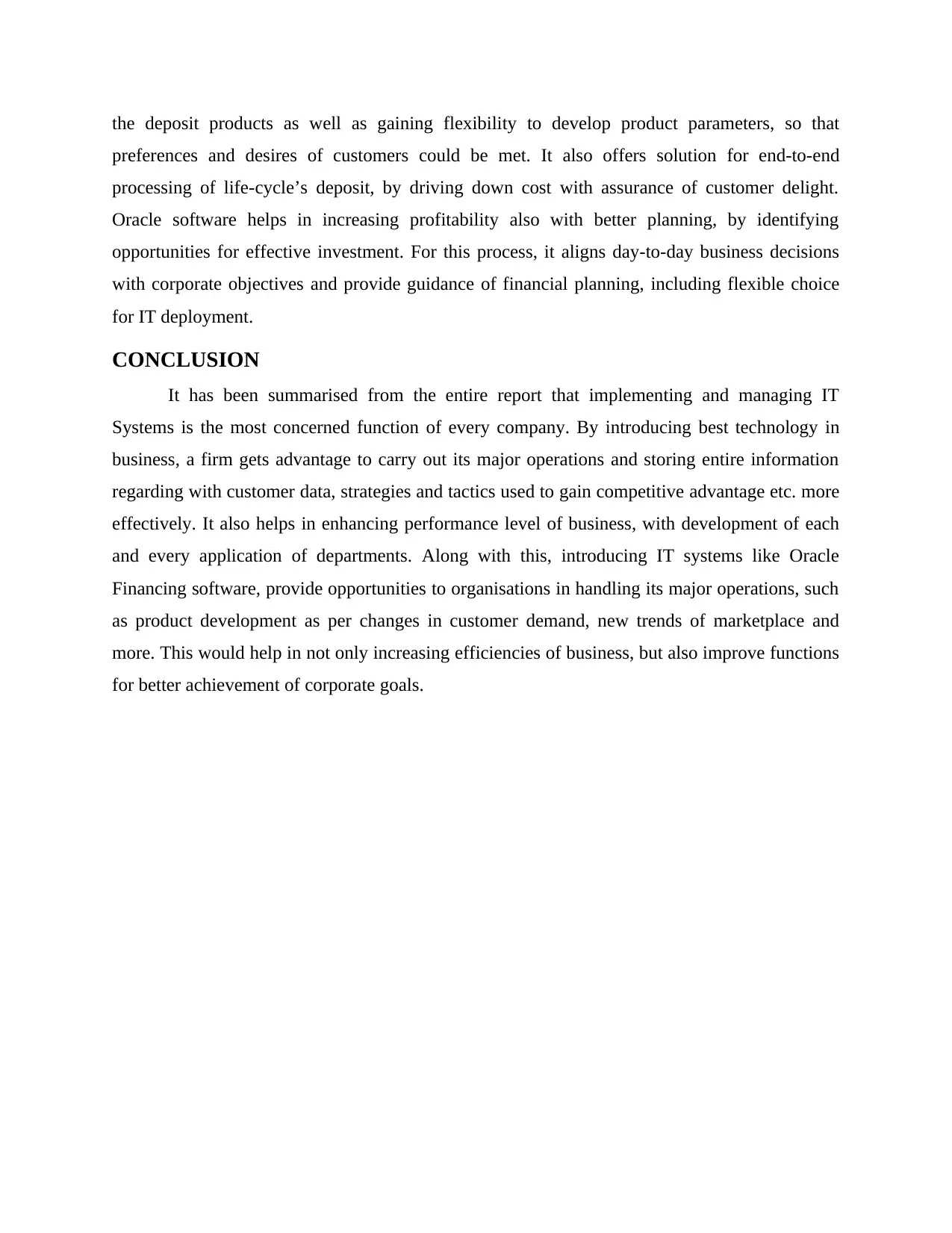
the deposit products as well as gaining flexibility to develop product parameters, so that
preferences and desires of customers could be met. It also offers solution for end-to-end
processing of life-cycle’s deposit, by driving down cost with assurance of customer delight.
Oracle software helps in increasing profitability also with better planning, by identifying
opportunities for effective investment. For this process, it aligns day-to-day business decisions
with corporate objectives and provide guidance of financial planning, including flexible choice
for IT deployment.
CONCLUSION
It has been summarised from the entire report that implementing and managing IT
Systems is the most concerned function of every company. By introducing best technology in
business, a firm gets advantage to carry out its major operations and storing entire information
regarding with customer data, strategies and tactics used to gain competitive advantage etc. more
effectively. It also helps in enhancing performance level of business, with development of each
and every application of departments. Along with this, introducing IT systems like Oracle
Financing software, provide opportunities to organisations in handling its major operations, such
as product development as per changes in customer demand, new trends of marketplace and
more. This would help in not only increasing efficiencies of business, but also improve functions
for better achievement of corporate goals.
preferences and desires of customers could be met. It also offers solution for end-to-end
processing of life-cycle’s deposit, by driving down cost with assurance of customer delight.
Oracle software helps in increasing profitability also with better planning, by identifying
opportunities for effective investment. For this process, it aligns day-to-day business decisions
with corporate objectives and provide guidance of financial planning, including flexible choice
for IT deployment.
CONCLUSION
It has been summarised from the entire report that implementing and managing IT
Systems is the most concerned function of every company. By introducing best technology in
business, a firm gets advantage to carry out its major operations and storing entire information
regarding with customer data, strategies and tactics used to gain competitive advantage etc. more
effectively. It also helps in enhancing performance level of business, with development of each
and every application of departments. Along with this, introducing IT systems like Oracle
Financing software, provide opportunities to organisations in handling its major operations, such
as product development as per changes in customer demand, new trends of marketplace and
more. This would help in not only increasing efficiencies of business, but also improve functions
for better achievement of corporate goals.
Paraphrase This Document
Need a fresh take? Get an instant paraphrase of this document with our AI Paraphraser

REFERNCES
Books & Journal
Alcacer, J. and Delgado, M., 2016. Spatial organization of firms and location choices through the
value chain. Management Science. 62(11). pp.3213-3234.
Avgerou, C. and Walsham, G. eds., 2017. Information technology in context: Studies from the
perspective of developing countries: Studies from the perspective of developing
countries. Routledge.
Benckendorff, P. J., Xiang, Z. and Sheldon, P. J., 2019. Tourism information technology. Cabi.
Benito, G. R., Petersen, B. and Welch, L. S., 2019. The global value chain and internalization
theory. Journal of International Business Studies. 50(8). pp.1414-1423.
Ge, L. and Li, C., 2019, April. Analysis of competitive Power of Chinese Sports Apparel Brand
based on Porter's five Force Model. In Proceedings of the 2019 3rd International
Conference on Information System and Data Mining (pp. 54-58).
Hernandez, V. and Pedersen, T., 2017. Global value chain configuration: A review and research
agenda. BRQ Business Research Quarterly. 20(2). pp.137-150.
Lee, H. L. and Tang, C. S., 2018. Socially and environmentally responsible value chain
innovations: New operations management research opportunities. Management
Science. 64(3). pp.983-996.
Lewis, R., 2017. Porter's Five Forces of competitive advantage.
Lloyd, I. J., 2017. Information technology law. Oxford University Press.
Senft, S., Gallegos, F. and Davis, A., 2016. Information technology control and audit. Auerbach
publications.
Simatupang, T. M., Piboonrungroj, P. and Williams, S. J., 2017. The emergence of value chain
thinking. International Journal of value chain management. 8(1). pp.40-57.
Singh, P. E., 2019. Impact of Market Forces on Engineering Consulting Industry. International
Journal of Management, IT and Engineering. 7(11). pp.190-193.
Taylor, P., 2017. The Globalization of Service Work: Analysing the 12 Transnational Call
Centre Value Chain. Working life: Renewing labour process analysis. p.244.
Thomas-Francois, K., von Massow, M. and Joppe, M., 2017. Service-oriented, sustainable, local
food value chain–A case study. Annals of Tourism Research. 65. pp.83-96.
Varelas, S. and Georgopoulos, N., 2017. Porter’s competitive forces in the modern globalized
hospitality sector–the case of a Greek tourism destination. J Tour Res. 18. pp.121-131.
Books & Journal
Alcacer, J. and Delgado, M., 2016. Spatial organization of firms and location choices through the
value chain. Management Science. 62(11). pp.3213-3234.
Avgerou, C. and Walsham, G. eds., 2017. Information technology in context: Studies from the
perspective of developing countries: Studies from the perspective of developing
countries. Routledge.
Benckendorff, P. J., Xiang, Z. and Sheldon, P. J., 2019. Tourism information technology. Cabi.
Benito, G. R., Petersen, B. and Welch, L. S., 2019. The global value chain and internalization
theory. Journal of International Business Studies. 50(8). pp.1414-1423.
Ge, L. and Li, C., 2019, April. Analysis of competitive Power of Chinese Sports Apparel Brand
based on Porter's five Force Model. In Proceedings of the 2019 3rd International
Conference on Information System and Data Mining (pp. 54-58).
Hernandez, V. and Pedersen, T., 2017. Global value chain configuration: A review and research
agenda. BRQ Business Research Quarterly. 20(2). pp.137-150.
Lee, H. L. and Tang, C. S., 2018. Socially and environmentally responsible value chain
innovations: New operations management research opportunities. Management
Science. 64(3). pp.983-996.
Lewis, R., 2017. Porter's Five Forces of competitive advantage.
Lloyd, I. J., 2017. Information technology law. Oxford University Press.
Senft, S., Gallegos, F. and Davis, A., 2016. Information technology control and audit. Auerbach
publications.
Simatupang, T. M., Piboonrungroj, P. and Williams, S. J., 2017. The emergence of value chain
thinking. International Journal of value chain management. 8(1). pp.40-57.
Singh, P. E., 2019. Impact of Market Forces on Engineering Consulting Industry. International
Journal of Management, IT and Engineering. 7(11). pp.190-193.
Taylor, P., 2017. The Globalization of Service Work: Analysing the 12 Transnational Call
Centre Value Chain. Working life: Renewing labour process analysis. p.244.
Thomas-Francois, K., von Massow, M. and Joppe, M., 2017. Service-oriented, sustainable, local
food value chain–A case study. Annals of Tourism Research. 65. pp.83-96.
Varelas, S. and Georgopoulos, N., 2017. Porter’s competitive forces in the modern globalized
hospitality sector–the case of a Greek tourism destination. J Tour Res. 18. pp.121-131.
1 out of 11
Related Documents
Your All-in-One AI-Powered Toolkit for Academic Success.
+13062052269
info@desklib.com
Available 24*7 on WhatsApp / Email
![[object Object]](/_next/static/media/star-bottom.7253800d.svg)
Unlock your academic potential
Copyright © 2020–2025 A2Z Services. All Rights Reserved. Developed and managed by ZUCOL.





